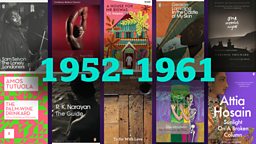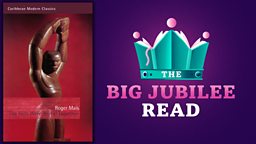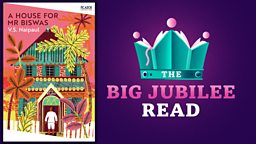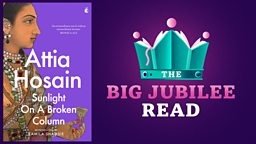The Big Jubilee Read: Books from 1952 to 1961
17 April 2022
Throughout this year of Platinum Jubilee celebrations, the Βι¶ΉΤΌΕΔ and The Reading Agency are celebrating 70 great books from across the Commonwealth. Read on to discover more about The Big Jubilee Read selections drawn from 1952 to 1961.


A celebration of literature from around the Commonwealth
An ex-RAF piliot confronts racism in the classroom, a young girl is caught up in the partition of India, and an alcoholic goes in search of his dead palm-wine tapster, in these novels written between 1952 and 1961.
The Reading Agency
-
![]()
The Big Jubilee Read is a partnership between the Βι¶ΉΤΌΕΔ and the Reading Agency.


The Palm-Wine Drinkard
by Amos Tutuola, Nigeria, 1952
Tutuola's novel is the phantasmagorical story of an alcoholic man and his search for his dead palm-wine tapster. As he travels through the land of the dead, he encounters a host of supernatural and often terrifying beings - among them a gentleman who returns his body parts to their owners, and the insatiable hungry-creature.
Mixing Yoruba folktales with what T. S. Eliot described as a 'creepy crawly imagination', The Palm-Wine Drinkard is regarded as a seminal work of African literature.


The Hills Were Joyful Together
by Roger Mais (Jamaica, 1953)
For the poor and black in this starkly brutal novel, little has changed since slavery. Surjue, like others in his Kingston yard, is struggling for survival when he is persuaded to take part in a robbery. He is arrested, tried and sentenced to the brutal world of a Jamaican colonial prison, yet his life outside jail is also a form of imprisonment.
First published in 1953 and set during the Second World War, Mais’s novel catches Jamaica at a point of change as country people flock into Kingston, but few find new beginnings.
- Discover more Jamaican writing (Βι¶ΉΤΌΕΔ Radio 4)


In the Castle of My Skin
by George Lamming (1953, Barbados)
Nine-year-old G. leads a life of quiet mischief, crab catching, teasing preachers and playing among the pumpkin vines. His sleepy fishing village in 1930s Barbados is overseen by the English landlord who lives on the hill, just as their 'Little England' is watched over by the Mother Country. Yet gradually G. finds himself awakening to the violence and injustice that lurk beneath the apparent order of things.
Lyrical and unsettling, Lamming's autobiographical coming-of-age novel is a story of tragic innocence amid the collapse of colonial rule.


My Bones and My Flute
by Edgar Mittelholzer (1955, Guyana)
Only when he is on board a steamer to a remote destination upriver in Guyana does Milton Woodsley realise that there is more to Henry Nevinson’s invitation to spend time with his family in their jungle cottage. Milton, an artist, thinks he has been invited to do some paintings for Nevinson, and possibly be thrust into the company of their daughter, Jessie. But when the Nevinsons mention a flute player that no one else can hear, Woodsley begins to realise that something else is afoot.
Mittelholzer's 1955 novel, subtitled “A Ghost Story in the Old-fashioned Manner”, combines tongue-in-cheek wit with genuine terror and a stark message about the need to exorcise the crimes of slavery.


The Lonely Londoners
by Sam Selvon (1956, Trinidad and Tobago)
At Waterloo Station, hopeful new arrivals from the West Indies step off the boat train, ready to start afresh in 1950s London. There, homesick Moses Aloetta, who has already lived in the city for years, meets Henry 'Sir Galahad' Oliver and shows him the ropes. In this strange, cold and foggy city where the natives can be less than friendly at the sight of a black face, has Galahad met his Waterloo?
Selvon’s novel celebrates a cohort of lonely Londoners who learn to survive and then come to love the heady excitements of their new home.
- A 1959 Βι¶ΉΤΌΕΔ Caribbean Service pamphlet called (The British Library)


The Guide
by R.K. Narayan (1958, India)
Raju used to be India's most corrupt tourist guide. His first stop after his release from prison is the barber's shop. He then decides to take refuge in an abandoned temple, where a peasant mistakes him for a holy man. Gradually, he begins to play the part, so God himself intervenes to put Raju's new holiness to the test.
The Guide is one of 22 books, written over 60 years, in which Narayan brings the fictional town of Malgudi to life.
- , the real place which inspired Narayan's Malgudi (The Guardian)


To Sir, With Love
by E.R. Braithwaite (1959, Guyana)
In 1945, Rick Braithwaite, a smart, highly educated ex-RAF pilot, looks for a job in British engineering. He is shocked to realise that, as a black man from British Guiana, no one will employ him because of the colour of his skin. In desperation he turns to teaching, taking a job in a tough East End school, and left to govern a class of unruly teenagers. With no experience or guidance, he attempts to instil discipline, confound prejudice and ultimately, to teach.
Braithwaite’s autobiographical novel inspired a much-loved film starring Sydney Poitier.


Un Nos Ola Leuad (One Moonlit Night)
by Caradog Prichard (1961, Wales)
Prichard’s novel – originally published in Welsh - tells of one boy's journey into the grown-up world. By the light of a full moon, the narrator and his friends Huw and Moi witness a side to their Welsh village life that they had no idea existed, and their innocence is exchanged for the shocking reality of the adult world.
One Moonlit Night is one of Britain's most significant and brilliant pieces of fiction, a lost contemporary classic that deserves rediscovery.
- J Elwyn Hughes celebrates the work of Caradog Prichard (Βι¶ΉΤΌΕΔ Radio Cymru)


A House for Mr Biswas
by V.S. Naipaul (1961, Trinidad and Tobago/England)
Mr Biswas has been told since the day of his birth that misfortune will follow him – and so it has. Meaning only to avoid punishment, he causes the death of his father and the dissolution of his family. Wanting simply to flirt with a beautiful woman, he ends up marrying her and relying on her domineering family for support. But in spite of endless setbacks, Mr Biswas is determined to achieve independence, and so he begins his gruelling struggle to buy a home of his own.
A House for Mr Biswas is Nobel Prize in Literature winner V. S. Naipaul's unforgettable masterpiece. Heart-rending and darkly comic, it is a classic that evokes a man's quest for autonomy against the backdrop of post-colonial Trinidad.
- V. S Naipaul discusses A House for Mr Biswas (Βι¶ΉΤΌΕΔ World Service)


Sunlight on a Broken Column
by Attia Hosain (1961, India)
Laila, the orphaned daughter of a distinguished Muslim family, is brought up in her grandfather’s traditional household by her aunts, who keep purdah. At fifteen she moves to the home of her ‘liberal’ but autocratic uncle in Lucknow. As the struggle for Independence sharpens, Laila is surrounded by relatives and university friends caught up in politics and finds herself in her own struggle against tradition.
With its stunning evocation of India, its political insight and unsentimental understanding of the human heart, Sunlight on a Broken Column is a classic of Muslim life.

More from The Big Jubilee Read
-
![]()
1962-1971
A Nigerian priest believes he has been chosen by his god, an Englishman and a South African join forces to modernise their community and a group of Australian schoolgirls vanish without trace.
-
![]()
1972-1981
An Indian family move from the countryside to the bustling city of Lahore, a retired spy is recruited to hunt down a mole in the British Secret Service and the Earth is demolished to make way for a hyperspace bypass.
-
![]()
1992-1991
A woman is forced to serve as a Handmaid in a dystopian future society, a German industrialist saves hundreds of Jews from death in Auschwitz and a Maori artist meets a mute six-year-old with a haunting past.
-
![]()
1992-2001
Two Second World War veterans try and rebuild a life in London, two twins grow up among political turmoil in Kerala and a young boy is stranded at sea with a ferocious Bengal tiger.
-
![]()
2002-2011
A commoner causes turmoil in the court of King Henry VIII, a London waterman is transported to New South Wales, and a Pakistani woman tries to create a day to remember.
-
![]()
2012-2021
A South African family gather for their mother's funeral, a young boy in Singapore sets out to discover what happened to his grandmother during the Japanese invasion and a ghost story unfolds on the goldfields of New Zealand.

Discover more about brilliant books across the Βι¶ΉΤΌΕΔ
-
![]()
Between the Covers
Sara Cox hosts the irreverent, entertaining TV show where books spark the banter
-
![]()
Turn Up For The Books
Surprising and friendly book recommendations from Dan Smith, Irenosen Okojie and Simon Savidge in this Βι¶ΉΤΌΕΔ Sounds podcast
-
![]()
Classic novels
Listen in full to a selection of classic novels on Βι¶ΉΤΌΕΔ Sounds, including Frankenstein, Animal Farm and Jane Eyre
-
![]()
Open Book
The Radio 4 programme looking at new fiction and non-fiction books, talking to authors and publishers and unearthing lost classics











